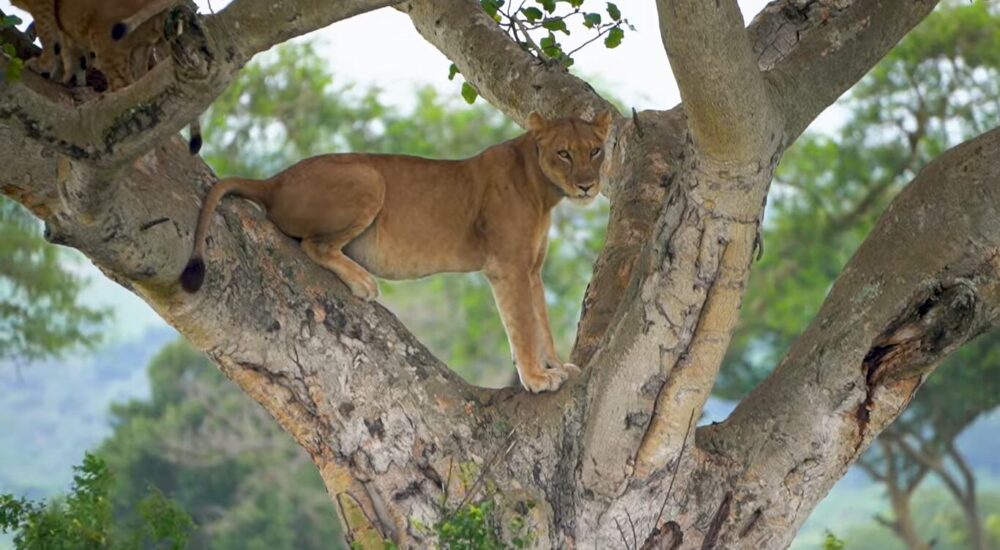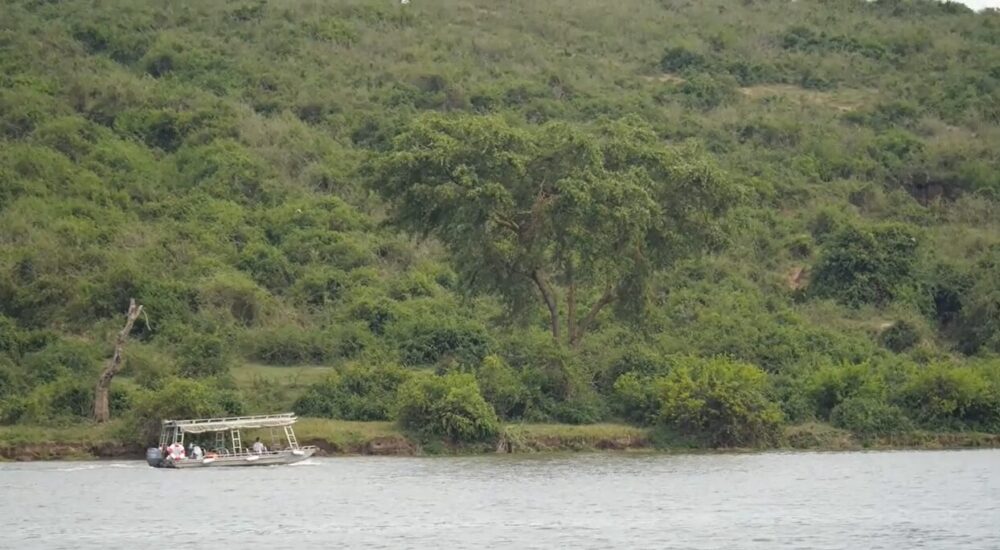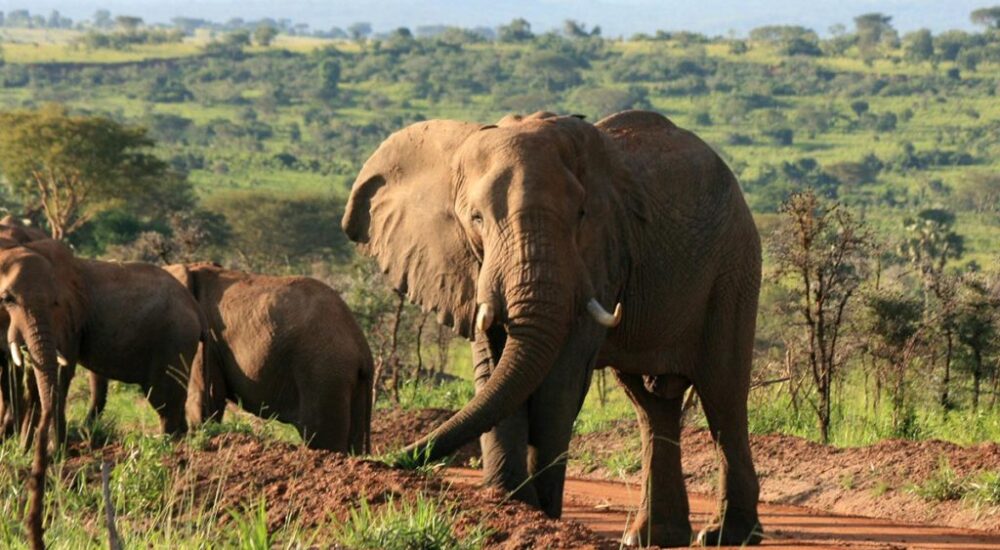Tree-climbing lions are one of the most extraordinary wildlife spectacles in Africa. Found in only…
Queen Elizabeth National Park
Queen Elizabeth National Park Uganda and Queen Elisabeth National Park tours welcome you.
A lot of people call Queen Elizabeth National Park “a Medley of Wonders.” This Uganda safari park is in the southwest of the country. It has a variety of ecosystems, including a large savanna, tropical rain forests, crater lakes, and wetlands. These habitats are good for many kinds of animals, including primates and birds, which is why so many people come here on Uganda Tours and Safaris.
Kazinga National Park, also known as Queen Elizabeth National Park, is set against the Rwenzori Mountains, which look like the moon. There are also beautiful views of Lake George and Lake Edward, as well as the park’s famous crater lakes. A lot of the famous Crator lakes are set between beautiful, green hills.
If you go to Queen Elizabeth National Park, you will have a unique chance to see the Kazinga Channel. Kazinga Channel is famous for having one of the biggest concentrations of hippos. You will also see a lot of elephants, buffalo, crocodiles, and other animals as they come to drink or bathe in the water, usually in the afternoon.
Researchers have found that being in a savanna can help you relax and deal with stress. You’ll feel the same way when you visit Queen Elizabeth National Parks’ Savannah lands of Ishasha. They are also home to the strange cats that climb trees.
If you have the chance to visit Queen Elizabeth National Park, you will not only get to see animals in the wild, but you will also have a unique culture experience. This gives tourists a chance to meet the locals and experience unique cultural activities like traditional dances, stories, and listening to traditional music. Most tourists loved the famous gin made from bananas and brought some back with them.
Kazinga National Park?
At first, the park was called Kazinga National Park. After Queen Elizabeth II visited, the name was changed to Queen Elizbeth National Park. Making it a special conservation area has paid off in real ways, protecting the ecosystems there for decades, even as the area around the park grows in people. Of course, it hasn’t been easy because there are more fights between people and animals. In less than six months, nine lions have been killed. Find out more about it here.
People who want to get close to animals can go lion tracking in Queen Elizabeth National Park, which is the only park in Uganda that lets people do that. You can also go on game drives, boat tours on the Kazinga Channel, monkey trekking in the Kyambura Gorge, walks through the Maramagambo forest, and visits to the Crator lakes, among other things.
You can go to Queen Elizabeth National Park at any time of the year, but the best times are from June to September (when it’s dry) and from December to January (when it’s not dry).
Not only is Queen Elizabeth National Park one of the best places to see wildlife in Uganda, it is also the most popular national park in the country. If you want to go gorilla climbing in Bwindi or Rwanda, don’t forget to stop by this park. It’s only 5 ½ hours from Rwanda’s Volcanoes National Park, 2 hours from Bwindi, and 3 hours from Kibale Forest National Park.
In Queen Elizabeth National Park, there is wildlife.
This is the best place in Uganda to see lions. They are most common on the grassy Kasenyi Plains, but in the Ishasha area, they are better known for the funny things they do while climbing trees. The grassland parts of the park are home to huge groups of buffalo and elephant, and the Kazinga channel, where daily boat trips are run, is home to an amazing number of hippos.
Queen Elizabeth National Park’s best parts
In the Ishasha area of the park, lions often rest in big fig trees. This is because they are good at climbing trees. It’s surprisingly easy to see giant forest hogs on both driving and boat trips. Due to breeding with forest buffalo from nearby Congo, buffalo are often a reddish brown color, which makes them look very attractive. In the lush, hot jungle of Kyambura Gorge, you can go trekking with chimpanzees.
The Kazinga Channel
Lake Gorge is to the east, and Lake Edward is to the west. The Kazinga channel is a natural river that runs for 32 kilometers (20 miles). An important part of Queen Elizabeth National Park is this river. Queen Elizabeth National Park is Uganda’s most popular game reserve and covers 1,978 square kilometers of land. The channel gives a stunning view of the most important wildlife projects in Queen Elizabeth National Park.
With a depth of 2.4 meters and an area of 250 square kilometers, Lake George is a small lake on the eastern side of the Kazinga Channel. This lake is fed by streams that come from the beautiful Rwenzori Mountains, which are right north of the lake. The extra water from Lake Gorge flows through the Kazinga Channel and into Lake Edward, which is close by and covers 2,000 square kilometers. It is one of Uganda’s largest freshwater lakes.
The beaches of the channel are home to many wild animals, birds, and reptiles all year long. The area has one of the biggest populations of hippos and a lot of Nile crocodiles. You can get a good look at these animals from a boat trip down the waterway or, more likely, from near the entrance to the beautiful Lake Edward. One of the best and most famous ways to launch a boat in the country is the Kazinga Channel Boat Cruise.
In Uganda’s Queen Elizabeth National Park, there are cats that climb trees.
Are lions strong enough to climb trees? It is very rare for cats to climb trees. These lions only live in two groups in the world, and they climb trees every day as part of their daily practice. In the Ishasha area of Uganda’s Queen Elizabeth National Park, which is in the south, you can find one of these groups. In the south of Tanzania, in Lake Manyara National Park, you can find the other group. In Uganda, you can go on a trek for three days.
Numerous people think that these lions climb trees to avoid the many biting tsetse flies that live on the ground, while others think that they do it to escape the heat on the ground and enjoy the cool breeze. However, no one knows for sure why they climb into the tree branches.
Bird watching in Uganda’s Queen Elizabeth National Park
One of the best places in Africa to see birds is in Uganda. Lots of different kinds of birds live there, some of which are only found there and nowhere else in Africa. Uganda is one of the best places in the world to see birds because it has so many great places to do so. You will see more than 1010 different kinds of birds on a tour in Uganda, and you will enjoy all of them. The many national parks in Uganda are where most of the country’s bird types can be found.
The crater explosion at Lake Katwe.
Several “explosion craters,” which are a very powerful type of extinct volcano, can be found in western Uganda. Their craters got their names from the fact that, unlike most volcanoes, these events were very violent and spread ash and rock over a large area instead of piling up around the vents. Most of them are now dead craters, but a few of them still give off sulfurous fumes.
The three main groups are the Katwe Explosion Craters in Queen Elizabeth National Park, the Bunyaraguru Crater Field on the stunning Kichwamba mountain, and the beautiful Ndali-Kasenda Crater Field close to Kibale National Park.
In Queen Elizabeth National Park in Western Uganda, the explosion craters offer stunning views and great hiking possibilities.
The crater lakes were formed not too long ago, between 8,000 and 10,000 years ago, by volcanic activity in Uganda. Even though they look calm and beautiful now, they were formed that long ago. When these went off, they really did a lot of damage—they covered an area bigger than what Mount Vesuvius did at Pompeii. Lake Edward became a poisonous mess because of the Ugandan Explosion Craters. As late as 2000 BC, when the Egyptian Pyramids were being built, fire and brimstone were still coming out of the explosion holes.
When Queen Elizabeth goes on a launch cruise or boat trip in Uganda
The boat ride through Queen Elizabeth National Park takes place in the Kazinga waterway, which is a natural waterway that runs for 40 kilometers and links Lake Edward to Lake George. Around here, the boat goes every day at either 9:00 a.m. or 2:00 p.m. This two- to five-hour launch tour will give you a chance to see the sea and plants along the coast of the Kazinga Channel in great detail.
There will be professional guides on this tour or trip who will tell you everything you need to know and answer any questions you have about the animals or anything else.
You can go on game drives and safaris in Queen Elizabeth National Park.
People take part in this activity by going through the park and looking at the animals. Around the park, there are a number of well-kept trails where you can watch animals.
The game tracks in this Uganda tours park are well taken care of and stretch for almost 200 kilometers.
Elephants, buffalo, lions, and many other kinds of antelope are more likely to be seen early in the morning, which is the best time to go on a game drive.
It takes about two hours to go on a boat cruise on the Kazinga channel. During that time, people can see yawning hippos, water birds, buffalo, elephants, zebras, Uganda-kobs, topis, water bucks, bush bucks, reed bucks, duiker, mongoose, swamp antelopes, spotted hyenas, warthogs, forest hogs, and in the south, difficult routes.
Queen Elizabeth Park has nature walks in the Maramagambo Forest.
Fans of birds and people who like to take walks away from the crowd will enjoy a half- or full-day in the Maramagambo Forest.
You can explore the shadows and find animals that you wouldn’t see on the open fields. You can also find hidden crater lakes and be amazed at how many living things are in a bat cave that is protected from the sun by a thick canopy.
Snakes hide in the cave floor’s rocks and are ready to grab bats that are thrown from their roost by bigger, more frantic neighbors. Don’t get too close.
Ishasha Plains is a national park in Queen Elizabeth.
To a deep part of our being, the Ishasha desert is alluring. If you feel drawn to the Ishasha area, stay there. The fig trees are nice, but don’t climb them. You might have to share the best branches with a lion or two.
Ishasha is an open forest area in the south-west part of the park. It is on the road to Bwindi Impenetrable Forest. You can explore it on game drives, and even though a few hotels have opened up in the area, not many people come to see it. This makes for amazing sunset drinks and very private game drives.
There are crater lakes in Queen Elizabeth Park.
The area’s turbulent volcanic past can be seen in all 72 of the park’s craters, which are all different sizes. Many of these are in the northern parts of the park, making for an interesting half-day trip that is more about the scenery and geology than the animals.
It’s amazing to think about how these holes formed—thousands of deep cuts in the Earth’s crust that were filled in by plants and animals over millions of years. The craters’ horrible and fiery past is very different from the lush, tree-filled haven of life that lives there now.
The best time to see wildlife
There is no such thing as a “ideal time to visit” Uganda. The country gets rain for most of the year because it is near the equator. Also, it looks like the weather is changing, which makes rigid timing useless. That’s why you should bring a protective jacket and be ready for anything.
During the months of June through early October and again from December through early March, it is cooler. In most places, it rains more in October and November and from March to the end of May. April and May are the driest months, but the last few years have been pretty dry.
There are five different parts to Queen Elizabeth National Park:
Edge of the Northeast Mweya Peninsula Rift Valley Edge of the Kyambura Gorge Ishasha area
Many different types of housing are available in each. Queens has a lot of different types of land, so there are a lot of different kinds of homes to choose from. You’ll have no trouble finding privacy or a great view.
Monumental Expeditions and Safaris doesn’t use all the resources that are available. Instead, we focus on the ones that have a history of making clients happy.
These are the places we like to stay the most.
Elephant plains
Lodge in Kyambura Gorge
Lodge in the Ishasha woods
Lodge in Enjojo
Lodge on Mweya Safari
Katara lodge
Climate and weather
Because Queen Elizabeth National Park is close to the equator, the weather there is always warm. The area has two wet seasons, which last from March to May and August to December. During these times, it rains a lot, making some roads impassable. There isn’t really a “Dry season,” but from January to February and June to July, it rains less, though not always all the time.
How to Get to Queen Elizabeth Uganda and How to Get Around. How to Get To Queen Elizabeth Park
Queen Elizabeth Park is a 1978 km2 park in western Uganda. It is shared by the Bushenyi, Bundibugyo, and Kasese areas.
A paved road from Kampala through Mbarara takes 5–6 hours to get to the park. A dirt road from Bwindi takes the same amount of time.
You can get to the park from Kampala by dirt road through Mbarara (420 kms) or by road through Fort Portal and Kasese (410 kms). It takes five to six hours to get to the park by road from Kampala through Mbarara. You can also get to this Uganda safari park from the Ishasha region of Bwindi Impenetrable National Park. Go on safari for seven days.


